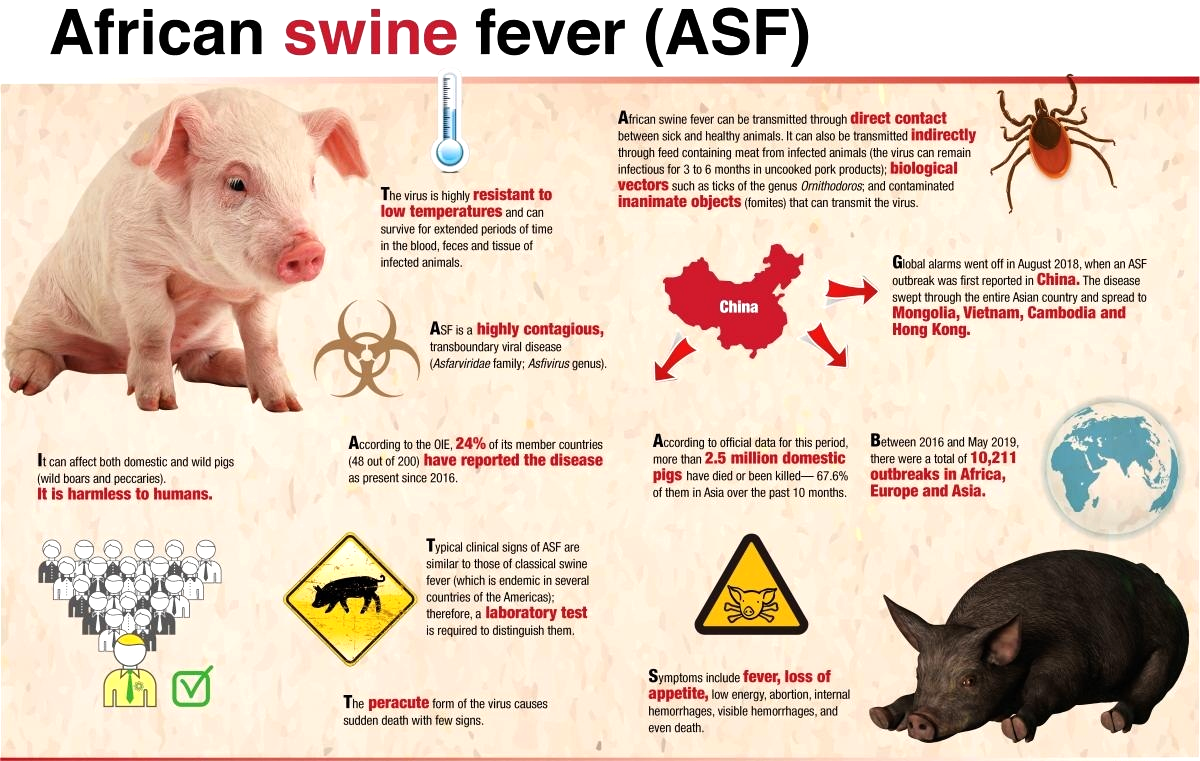African Swine Fever in India | 02 Aug 2022
For Prelims: African Swine Fever, Classical Swine Fever, ICAR, IVRI, WOAH, Vaccination
For Mains: Effects of Swine Fever on Economics of Animal Rearing, Role of World Organisation for Animal Health
Why in News?
Recently, African Swine Fever has been confirmed for the first time, at a private pig farm in in Kerala, after more than 15 pigs on the farm had died due to the disease in the last ten days.
What is African Swine Fever?
- About:
- It is a highly contagious and fatal animal disease that infects and leads to an acute form of hemorrhagic fever in domestic and wild pigs.
- Other manifestations of the disease include:
- High fever
- Depression
- Anorexia
- Loss of appetite
- Hemorrhages in the skin
- Vomiting and diarrhoea among others.
- It was first detected in Africa in the 1920s.
- Historically, outbreaks have been reported in Africa and parts of Europe, South America, and the Caribbean.
- However, since 2007, the disease has been reported in multiple countries across Africa, Asia and Europe, in both domestic and wild pigs.
- Historically, outbreaks have been reported in Africa and parts of Europe, South America, and the Caribbean.
- The mortality is close to 95% - 100% and since the fever has no cure, the only way to stop its spread is by culling the animals.
- ASF is not a threat to human beings since it only spreads from animals to other animals.
- ASF is a disease listed in the World Organisation for Animal Health (OIE)’s Terrestrial Animal Health Code.
- Clinical Signs:
- The clinical signs of ASF may occur in chronic, sub-acute or acute form.
- In the acute form pigs develop a high temperature (40.5 degrees C or 105 degrees F), then become dull and go off their food.
- Other symptoms can vary but will include some or all of the following:
- Vomiting
- Diarrhoea (sometimes bloody)
- Reddening or darkening of the skin, particularly ears and snout
- Gummed up eyes
- Laboured breathing and coughing
- Abortion, still births and weak litters
- Weakness and unwillingness to stand
- The clinical signs of ASF may occur in chronic, sub-acute or acute form.
- Transmission:
- Direct contact with infected pigs, faeces or body fluids.
- Indirect contact via fomites such as equipment, vehicles or people who work with pigs between pig farms with ineffective biosecurity.
- Pigs eating infected pig meat or meat products.
- Biological vectors - ticks of the species Ornithodoros.
What is Classical Swine Fever?
- CSF, also known as Hog Cholera, is an important disease of pigs.
- It is one of the most economically-damaging pandemic viral diseases of pigs in the world.
- It is caused by a virus of the genus Pestivirus of the family Flaviviridae, which is closely related to the viruses that cause bovine viral diarrhoea in cattle and border disease in sheep.
- Mortality rate of Classical Swine Fever is 100%.
- Recently, the Indian Council of Agricultural Research ICAR-Indian Veterinary Research Institute IVRI developed a Cell Culture CSF Vaccine (live attenuated) using the Lapinized Vaccine Virus from foreign strain.
- The new vaccine has been found to induce protective immunity from day 14 of the Vaccination till 18 Months.
What is the World Organisation for Animal Health?
- WOAH was formerly called the “Office International des Epizooties”.
- OIE is an intergovernmental organisation responsible for improving animal health worldwide.
- It has 182 Member Countries.
- India is one of the member countries.
- OIE develops normative documents relating to rules that Member Countries can use to protect themselves from the introduction of diseases and pathogens.
- One of them is the Terrestrial Animal Health Code.
- OIE standards are recognised by the World Trade Organization as reference international sanitary rules.
- It is headquartered in Paris, France.
UPSC Civil Services Examination, Previous Year Questions (PYQs)
Q. H1N1 virus is sometimes mentioned in the news with reference to which one of the following diseases? (2015)
(a) AIDS
(b) Bird flu
(c) Dengue
(d) Swine flu
Ans: (d)
Explanation:
- H1N1 virus is related to Swine Flu.
- The World Health Organization declared the flu caused by H1N1 to be a global pandemic in 2009.
- Symptoms of Swine Flu include fever, cough, sore throat, chills, weakness and body aches.
- The swine influenza genome has 8 different regions which are segmented and encode 11 different proteins:
- Envelope proteins Hemagglutinin (HA) and Neuraminidase (NA).
- Viral RNA polymerases which include PB2, PB1, PB1-F2, PA, and PB.
- Matrix proteins M1 and M2.
- Nonstructural proteins NS1 and NS2, which are crucial for efficient pathogenesis and viral replication.
- Therefore, option (d) is the correct answer.

